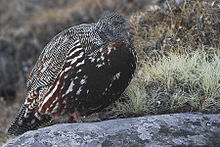Snow partridge
| Snow partridge | |
|---|---|
 |
|
| Snow Partridge from Kedarnath Wildlife Sanctuary | |
| Scientific classification | |
| Kingdom: | Animalia |
| Phylum: | Chordata |
| Class: | Aves |
| Order: | Galliformes |
| Family: | Phasianidae |
| Subfamily: | Perdicinae |
| Genus: |
Lerwa Hodgson, 1837 |
| Species: | L. lerwa |
| Binomial name | |
|
Lerwa lerwa (Hodgson, 1833) |
|
| Synonyms | |
|
Lerwa nivicola |
|
Lerwa nivicola
Perdix lerwa protonym
The snow partridge (Lerwa lerwa) is a gamebird in the pheasant family Phasianidae found widely distributed across the high-altitude Himalayan regions of India, Pakistan, Nepal and China. It is the only species within its genus. The species is found in alpine pastures and open hillside above the treeline but not in as bare rocky terrain as the Himalayan snowcock and is not as wary as that species. Males and females look similar in plumage but males have a spur on their tarsus.
This partridge appears grey above and chestnut below with bright red bill and legs and the upperparts finely barred in black and white. In flight the pattern of dark brown primaries and secondaries with a narrow trailing white margin make them somewhat like the much larger Tibetan snowcock. The 14-feathered tail is dark and barred in white. There is variation in the shade and some birds have a nearly black crown. The primaries and secondaries are brown and the breast is deep chestnut. The abdomen has more white and the lower flanks and feathers around the vent are barred brown and white. The under-tail coverts are chestnut with black shaft streaks and white tips. Young birds have the lower parts mottled and the barring less distinct. The tarsus is feathered on the front of the leg half-way to the toes.
It measures 38–40 cm in length. Females weigh 450–580 g; males, 550–700 g. Sexes are similar in plumage, female lacks spurs on the tarsus while the male has a blunt spur and sometimes a second incipient spur. Downy chicks have a resemblance to the chicks of the blood pheasant. Chicks are born with the tarsi feathered and the nostril opening is covered by feathers.
...
Wikipedia

